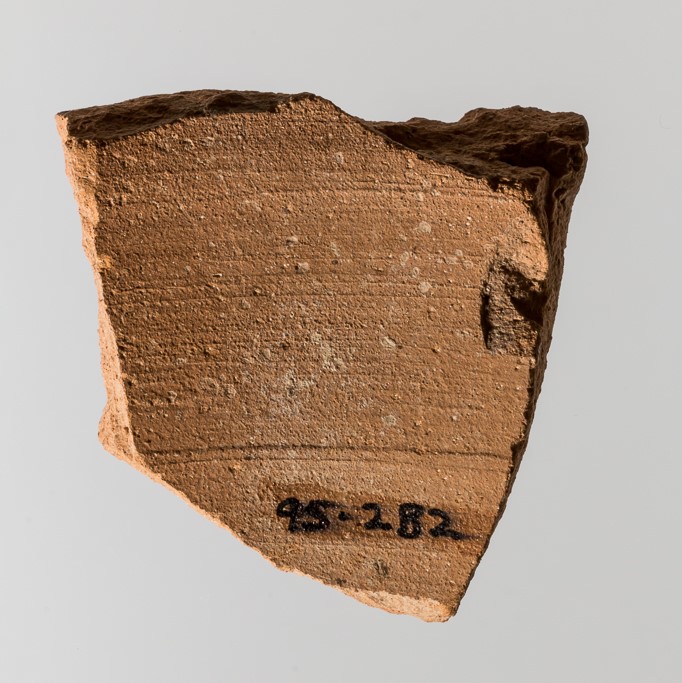Title: Potsherd with graffito - 2013.01
Acquisition number: 2013.01
Author or editor: Emma Griggs
Culture or period: Hellenistic.
Date: 3rd - 2nd century BC.
Material: Clay - Terracotta
Object type: Pottery
Origin region or location: Syria
Origin city: Jebel Khalid.
Display case or on loan: 6
Keywords: Hellenistic, Jebel Khalid, Potsherd, Graffito, Dionysios Nikias
G. W. Clarke, ‘A Greek graffito from Jebel Khalid’, Mediterranean Archaeology 9/10, 1996/7, 185-186
G. W. Clarke and H. Jackson, ‘Can the mute stones speak? Evaluating cultural and ethnic identity from archaeological remains: the case of Hellenistic Jebel Khalid’, The Journal of the Australian Academy of the Humanities 2, 2011, 17-18
2013.01
Potsherd with graffito
On loan from Professor Graeme Clarke AO FAHA, co-director of excavations at Jebel Khalid, Syria.
Length: 5cm; height: 4.8cm. The letter sizes range between 0.5cm and 0.8cm high.
The graffito reads: ΔΙΟΝΥ[ΣΙΟΣ]
ΝΙΚΙΑΣ
(Diony[sios] Nikias)
This potsherd has the name Dionysios Nikias, the owner of the vessel, scratched onto the surface. The item was found in Trench 55 in the Acropolis complex during the 1995 excavation season at Jebel Khalid. Trench 55 uncovered an unusually large number of coins and pottery items including lamps, pots and potsherds. This particular sherd belonged to a large coarse-ware wheel-made vessel. The vessel's fabric and interior have an orange-buff tone, and the exterior is a light pinkish white, a common colour scheme for large coarse-ware vessels found at Jebel Khalid.
This potsherd is Hellenistic and has been dated to around the later part of the first century BC. Such a date has been reached through an analysis of the writing style. Of the more than 80 other graffiti recovered at the site, overwhelmingly Greek letters have been used, indicating that, for the most part, Greek was the written language of choice at Jebel Khalid.
The name Dionysios Nikias is undeniably Greek in origin. The name Dionysios is a relatively common personal name found in Syria, but the name Nikias is less commonly found. This sherd documents the only full name found at the entire site, disregarding the names on the largely imported stamped amphora handles.
G. W. Clarke, ‘A Greek graffito from Jebel Khalid’, Mediterranean Archaeology 9/10, 1996/7, 185-186
G. W. Clarke and H. Jackson, ‘Can the mute stones speak? Evaluating cultural and ethnic identity from archaeological remains: the case of Hellenistic Jebel Khalid’, The Journal of the Australian Academy of the Humanities 2, 2011, 17-18
On loan from Emeritus Professor Graeme Clarke.

